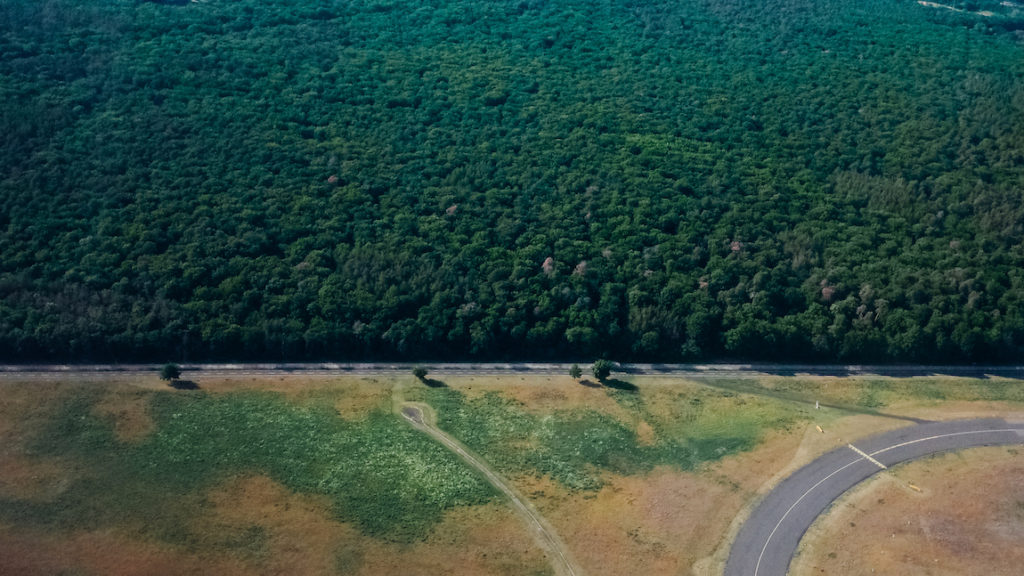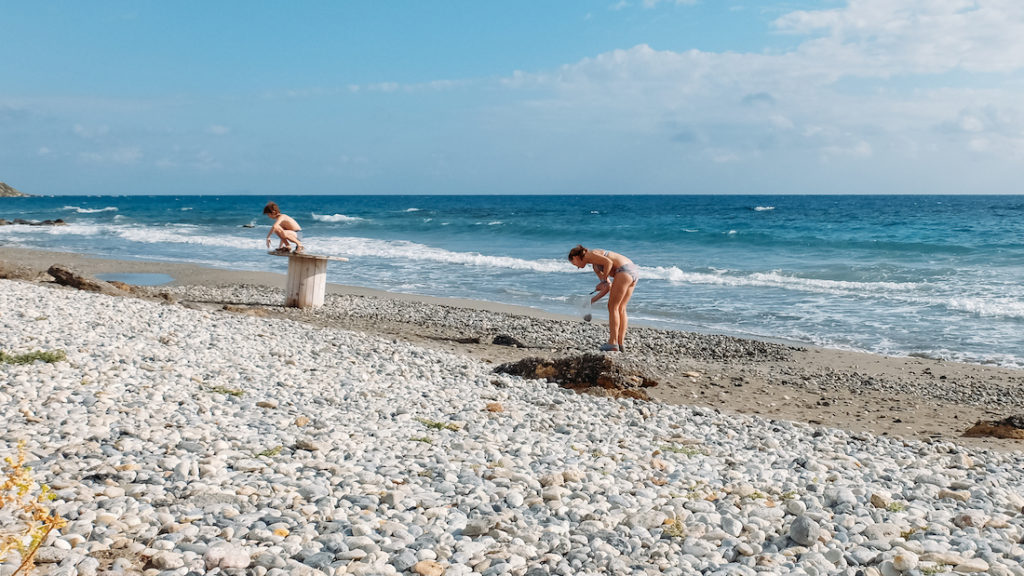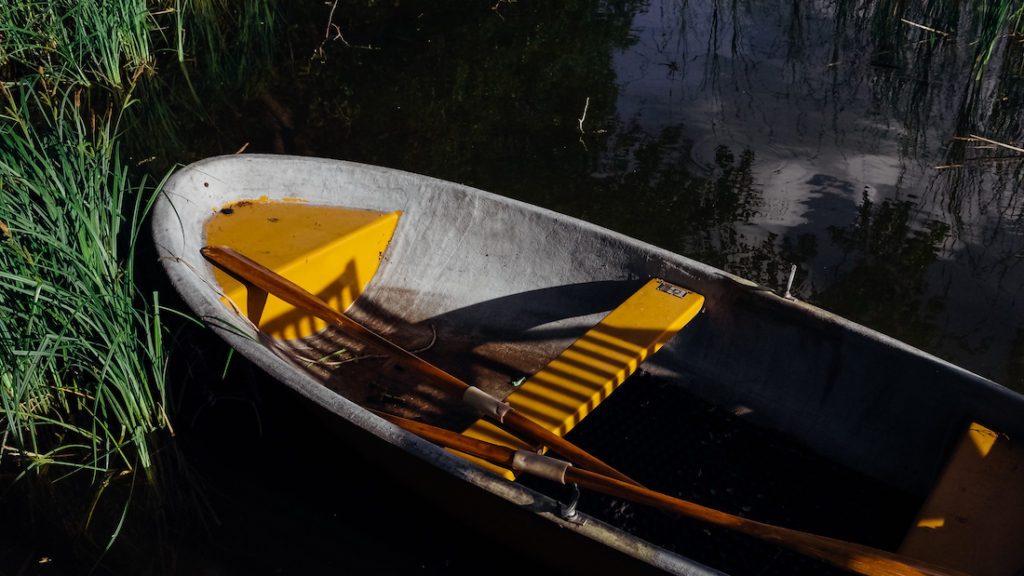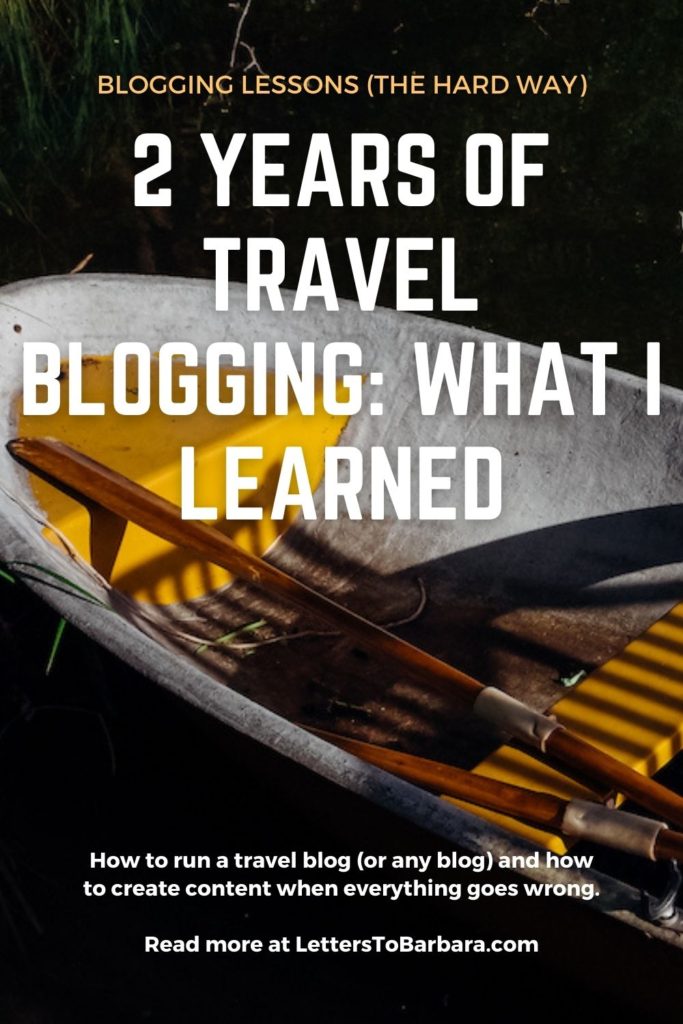Every September, on the occasion of the Letters to Barbara anniversary, I try to write a roundup post. Apart from the personal milestone, such posts are usually encouraging and useful for people willing to start a blog. A joyous mood can be detected throughout such articles, and new goals are announced. However, even though I’m celebrating two years of travel blogging today, I must warn you: this won’t be the most optimistic post you read. And here’s why.
If you read last year’s article for the first anniversary of the blog, you might remember the cheerful tone of the post. Reaching a milestone is always a good reason to celebrate and share this joy with the readers. Subsequently, reaching two years of travel blogging should also be a reason to be happy, right? Yes, on the one hand, I’m delighted, but on the other, I must admit that I feel pessimistic. Why’s that? Well, the pandemic changed our lives for good, and travel restrictions prevent us from traveling. That said, running a travel blog in the times that no one is allowed to travel freely sounds almost ironic.
I could potentially write an article on how the pandemic changed traveling, but I’d rather not do that. Apart from being a saturated topic, it would have little or no value for people that need to know a few things about blogging. Or even about how you can run a blog as a business. So, instead of focusing on the effects of a situation that makes us miserable, I thought of writing about the lessons I learned the hard way.
Therefore, after two years of travel blogging, I guess it’s an excellent opportunity to write about how you can still run a travel blog when everything is falling apart. This year, I struggled a lot with writing, shooting photos, and creating content in general. Bad times come, but also bad times go: so, here’s to two years of Letters to Barbara and here’s also how to carry on writing when you think that the blogging game is over for you.
Two years of travel blogging: Lessons I learned (the hard way)

1) Start a blog -and be ready for a disaster

This line should by no means discourage you. On the contrary, blogging (and especially travel blogging) is one of the most beautiful things out there. It means that you want to run something entirely on your own and be the boss of yourself. What I actually mean here is that if you want to monetize your blog and you treat it like a business, you must be ready for bad times. Subsequently, you should also be ready for a disaster.
Being ready for a disaster translates to several things. First of all, if things go wrong, you will see a sudden drop in traffic. I don’t just mean losing some dozens of visitors: you might actually lose even 70% or 80% of your traffic. Now, one should never do things just for metrics. But here’s the thing: if you try to make some money from your blog, a drop in your blog’s traffic also translates to a massive drop in income. Of course, if you just run your blog for fun, you won’t probably mind. But, if you invested time and money, seeing your blog going back to the metrics of the first months is discouraging. And that’s, honestly, the softest way to describe it. A more accurate word is devastating.
So, what does it really mean to be ready for a disaster? Well, it means that you should know beforehand that bad times will come. And have a plan for such bad days. It might not be a disaster, but if you think that your blog will always grow, I can assure you that it won’t. There will be times of exponential growth, but there’ll be times that traffic will be in a coma. And yet, that’s not a disaster. The catastrophe in blogging terms is the exponential decline of your traffic. And that’s what precisely happened in 2020 for every travel blog out there.
2) Change your content but not your habits

And yet, here you are, willing to run a travel blog when things don’t go well. I don’t think that there’s a right or wrong approach here. Therefore, I’m just going to share what I actually did and why it worked for me.
Instead of entering a self-pity mood for months, I decided to carry on writing. Moreover, I also decided to keep my regular posting schedule. In good times, I’d post every Wednesday and Saturday, but when everything started going to hell, I chose to post just every Saturday. Now, one might ask: what can you write about traveling if you can’t travel at all? Well, there’s actually plenty of stuff.
I tried to take advantage of some of my “privileges.” Don’t expect anything fancy. One such “privilege” is that I live in Berlin, Germany. Since Berlin is one of the most popular cities for travelers, I decided to do something that I haven’t done in the past: to write about Berlin. On the other hand, I’m Greek: therefore, I could write about Greece, one of the most desired countries for summer vacations. Okay, you might think. But what to write about your hometown or your city of residence?
Lots of things. From a visit to a museum to a city guide, and from a rant about a local issue to a short day trip. The possibilities are really numerous. It doesn’t mean that you won’t have to struggle, or everything will be easy. No. But the content is there, waiting for you to write it.
All that said, after two years of travel blogging, I realized that there are more things to write on a travel blog. Past journeys can also be a part of your posting schedule. Or to focus on the city that you live in. It took a disaster for me to understand that -and then I tried to make the most out of it.
3) You post today, but you do it for the future

The days you upload a new post, there’s always a rise in the metrics. There’s a spike in traffic, and more people will most likely visit your blog. For times that your website will be in a coma, this is almost heartwarming. A day or two later, the spike is gone, and the blog goes back to sleep mode.
And then, you have an idea: why not post more and more and see that spike more often? For two reasons. The first one is that sooner rather than later, you will run out of content. This will translate to stress, sleepless nights, and obsessing with the metrics. That’s not healthy. Do you remember that when you started blogging, it was fun? It should still remain fun, even if it’s your business.
The second reason is that, as I wrote in the subtitle, you post today, and you do it for the future. Let me explain that. By posting more, you’ll most likely start reducing the quality of your writing at some point. And this doesn’t only mean that people might find your texts less attractive. The texts might also not rank well on search engines. The goal is for your texts to receive traffic months and -ideally- even years after writing them. Low-quality texts that are not SEO optimized will give you that sudden spike, but everyone will soon forget them: by you, the readers, and -most importantly- by the search engines.
Writing for the spike is a panic reaction. It’s better -and more sustainable- to write for the future. That’s what I tried to do during that disaster. Even though the traffic resembled a straight line, I could see that I almost tripled the keywords I ranked for. What does this practically mean? It means that the content is there to be found when people re-start searching for it. In my case, when travel resumes.
4) If you panic, don’t go on social media

I wrote several times in the past that I don’t have faith in Social Media anymore. First of all, they feel less social and more media. Second, in terms of promoting your blog, the outcome is dubious. Even in good times, the exposure and the clicks you’ll get back to your blog/website won’t change drastically. All Social Media want you to spend time there, and their algorithm will drown every link that drives users away from them. Post a photo (the user stays in the platform), and you’ll get X exposure. But post a link, and the exposure is X/3 or X/4.
For vanity reasons or for the dying influencer marketing, Social Media might still be kind of okay. But for promoting your blog for free, they are almost dead. If you want to bring traffic to your website, you will have to pay. So, if you panic and you think that overexposing yourself to Social Media will bring you loads of traffic, this won’t be the case unless you spend money. Therefore, if there’s a budget that you can pay for months in a row, yes, you can expect some traffic. But a weekly campaign will be just a one-week spike. Do you need that? I don’t.
Yes, successful Social Media accounts might mean something. They might also translate to some job opportunities (they are becoming significantly less). But if I were you and I was willing to grow my blog through Social Media traffic, I’d look elsewhere. It only takes an algorithm update on Instagram or Facebook to devaluate your account completely. Doing all the hard work for years and then wake up one day with zero doesn’t make any fun.
5) When everything goes wrong, invest in the right tools

Yes, it’s very challenging to invest money (and time) when everything goes wrong. These will be times of little or no income, and yet you have to spend. But if you can afford it and think it’ll help you, don’t hesitate to go for it.
When I realized that the future of my blog was at stake, I decided to take action. In past posts, I wrote about the importance of paid and free tools. But what do I mean by the right tools? My definition is “the tools that will help you run and maintain your blog while making your workflow easier.” Seeing the Letters to Barbara declining because of the pandemic didn’t mean that the blog wouldn’t have expenses anymore. On the contrary, it meant that I’d have to pay some money even if my income was low.
For example, I didn’t even consider canceling Grammarly. That’s one of the most useful tools for a writer. Grammarly corrects your texts and offers you suggestions regarding your writing. Apart from all the mistakes that non-native English speakers make, Grammarly is also helpful for native speakers. You’ll always have a comma missing, and spelling mistakes or typos won’t disappear. Canceling my subscription would mean compromising the quality of my texts. So, I didn’t even consider it, and I renewed it.
Then, I saw that Pinterest started to bring some traffic. I know what you think: “you just said no Social Media, George.” True. But Pinterest is more of a search engine and less of a Social Media. You go on Pinterest to search for things and create boards. You’re not there for tapping hearts and similar interactions. Long story short, when I realized that Pinterest was giving me something back, I invested in a scheduler. I bought a Tailwind subscription and thought of giving it a try. I did that because a) it made my workflow faster and smoother, and b) I wanted to see if there’ll be a constant rise in traffic.
And the same goes for KeySearch. When I realized that I should remain focused on content for the next months, I decided to invest in software that could help me find keywords. KeySearch helps me to find keywords that I could potentially rank for. Moreover, it gives you opportunities for SEO optimization. Sure, there is better and more accurate software out there like, for example, Ahrefs. But I’m running a blog and not a business, which means I couldn’t afford the cost. KeySearch is ideal for bloggers that take blogging seriously. And that’s why I bought it. If you are interested in SEO, click here for the Annual Program and use my code, LTB20, at checkout for getting 20% off on their annual plan.
Every paid software needs time to prove its usability. You can’t expect miracles overnight. However, I use Grammarly, Keysearch, and Tailwind heavily, and I will write reviews for each one soon. The takeaway point here is: even if things go wrong, invest if you can afford it. Keep an eye on the long-term results and not on small traffic spikes. If the services deserve your money, renew them; if not, skip them after they expire.
6) You own nothing but your mailing list

Of course, you own your website, your laptop, and your camera. And most likely a bunch of other things too. But when it comes to blogging assets, the only thing you own is your mailing list. And you should treasure it and treat it appropriately.
The people that decide to subscribe to your mailing list saw something interesting on your blog. It might be your writing, your photos, your sense of humor, your descriptions, anything. But they subscribed, and they want to hear from you. They decided to follow you, and they will click the links you provide and bring you some extra traffic. Or, if you create products, they might consider buying them.
Growing my mailing list (I use Mailerlite) was one of the top goals in this challenging year. But it’s not just about numbers or traffic. It’s mainly because this one is of the most humane ways to connect in the digital world. Most of your blog’s readers will forever remain anonymous, and you won’t have the chance to get to know them. But when you have a mailing list, people have a name and address. You can reach out to them, and they can reply to you. In bad times, my mailing list always cheered me up. The people responded to my e-mails, and they read my new posts. Honestly, it’s just because of them that I carried on writing this horrible year.
7) Do things your way -and then evaluate

While it is essential to treat your travel blog as a business, it is equally important to do things your way. Don’t let anyone convince you that you have to do what everybody else does. No, you don’t. Your blog should have a unique voice: yours. If you end up doing the same things as everybody else, why should one read your blog? People should visit your website to see what you have to say, not saying the same thing as some other blogger.
That said, some of the articles you’ll write might not receive traffic. Or others might not bring any sales at all. While this could be a reason to worry, it doesn’t mean that you have to skip them -especially if these are your most loved articles. On the other hand, being stubborn is one thing and being flexible is another. Yes, I find it important to do things your way, but it’s also essential to evaluate them. So, at some point, you should decide whether you should change your tactic or not. If, after evaluating, you are happy with what you do, then keep on doing it. If not, try to change it.
For example, some of my favorite articles on this blog do not convert at all in terms of sales (like this travelogue about Odessa). Such posts do not generate money, and the traffic is rather low. So, I thought of evaluating my travelogues approach. Do they work? Do they offer something? Or is it just me that I enjoy reading them?
Then, I saw the bigger picture. While the travelogues don’t bring money back to the website, they have the highest subscription rate to my mailing list. This is because the more dedicated readers of my blog read them. Apart from that, these are the texts I enjoy writing the most. Therefore, I decided to keep on writing them.
So, when you are evaluating your content approach, make sure to check every aspect. It’s not everything about money in this world. If there’s a reason to continue doing the things you love, don’t even think of skipping them. Yes, that’s not a 100% business approach, but then again, life is also about pleasure. Remember: blogging should also be fun.
8) When everything looks bad: dream

Sounds like a terrible cliche? I bet it does. But even in the darkest days, we still have the right to dream. I spoke extensively about some ugly sides of blogging here, so I thought of reminding you that not everything is terrible. In fact, when your blog will enter the bad days spiral (it will happen at some point), it is essential to remember why you embarked on the blogging journey. Was it for traveling more? Or because you wanted to create an extra income stream for yourself? Did you want to keep your travel memories alive? Or maybe you just felt that no one understood you, and you longed for some virtual connection with like-minded people?
Try to bring all of these initial thoughts and sentiments in mind and try to build upon them. And this subsequently means that, no matter what, you’ll have to keep those dreams alive. I survived the dark days of the lockdown by daydreaming of journeys. Whenever everything was just horrible news, I kept on writing to escape reality. And when everything looked black, I tried to lift my spirits a bit. The blog hasn’t seen such a bad period. And yet, I thought that I should not give up.
No matter what, don’t give up.
Bonus: My travel blogging tips & recommended software

So, in this sub-section, I’m adding my travel blogging resources. While most of them deal with travel blogging, the truth is that they apply to any kind of blog. So, here you will find some of my travel blogging posts, and I’m also adding a few links to the software I use for running my website smoothly. So, after two years of travel blogging, here’s what I have for you.
Blogging tips
- How to start a travel blog (or any type of blog). Here I’m breaking down the process of how you can create a blog in half an hour. I always update this post with current trends, web hosting offers, recommended plugins, and more. Read my blogging guide here, and make sure to bookmark it for future use.
- Choose your blog name. After many readers asked me about tips on choosing their blog name, I thought of writing an article. I analyze the process I used to select a blog name and explain how I chose mine. See how to pick the best name for your blog here.
- 12 Things I learned after six months of travel blogging. That’s actually my very first post about blogging. However, I still find those things relevant -especially when things go smoothly. Read the 12 things here.
- What I learned after a year of travel blogging. That’s the article I wrote for the first milestone of the Letters To Barbara. I celebrated it on the remote Greek island of Anafi, and it’s a long read. Loads of tips and behind-the-scenes info. Read the article here.
- How to become a writer. Here’s it’s all about creating a writer’s mindset. From how to organize your day to how to motivate yourself. See the article about becoming a writer here.
- Blogging gear for minimalists. Here I thought of presenting my blogging gear. Even though it’s more of travel blogging equipment, you can run smoothly any blog with it. As for the “minimalists” term, well, this translates to lightweight gear and just a small number of devices. I’m sure that it will save you money and trouble. Check my blogging equipment here.
- Bluehost Review: Pros, Cons & Tips. That’s a review of my web hosting provider, Bluehost. If you are just starting in the blogosphere, I believe that Bluehost is the best web hosting provider. Read the review here.
- 12 Travel Writing Tips. Last but not least, that’s my ebook about travel writing. I’m offering the travel writing tips that helped me write my travelogues for more than ten years. You can see more info and purchase a copy of my ebook here.
Recommended Paid Software
- Grammarly. That’s the software I use for editing my travel blog articles. They offer loads of suggestions, and the AI is advanced. I use the Pro version, and I’m delighted with it. Check Grammarly here.
- Tailwind. The Pinterest scheduler I use. It comes together with the Tribes option that helps you share your pins with other like-minded creators. It also has an Instagram Scheduler. Click and see Tailwind’s exclusive offer for Pinterest here. If you follow the link, you can test it for one month for free.
- KeySearch. The software I use for finding keyword ideas and checking different kinds of metrics. A must tool if you are willing to do proper SEO (you should do that). Follow this link to KeySearch’s website and add the code LTB20 on checkout to receive a 20% reduction in any annual plan. If you can only buy one plugin, then KeySearch is the one. Read my KeySearch review here.
Two years of travel blogging: final thoughts
After two years of travel blogging, I can’t imagine my life without writing this blog. Sure, this year’s conditions were not optimal, but they taught me a lot. Running a blog about traveling in terms of a pandemic was one of the most challenging things I did. And yet here I am, enjoying every moment of it. Do I have bad days? Sure. And they are actually plenty due to the current situation. But, once again, I decided to look at the big picture.
And the big picture says that this blog kept me sane during bad times. Moreover, it helped me to travel a lot and write more than ever in my life. So, yes, I will keep on writing, and I’ll continue running the blog. Your feedback and your kindness kept me doing that, and I don’t plan to betray you. So, a big thanks to every single reader out there. Here’s to two years of Letters to Barbara and our future journeys.
What happened next? Here’s how it feels to be a travel blogger for three consecutive years.
See more of my writing and blogging articles here.
Are you interested in travel writing? Check my ebook about travel writing here.
Pin it for later

Please share, tweet, and pin if you enjoyed reading Two years of travel blogging: what I learned. Your support keeps this website running and all the info up-to-date. 🙂
Last Updated on September 18, 2021 by George Pavlopoulos









George, using Tailwind has been on my to do list for a while now but I still find Pinterest very mysterious. I can understand how someone visits your blog, sees a post they like and wants to pin it for future reference. I can also see how someone can visit your blog if they do a google search and Pinterest shows a page with your pin on it. But how it chooses what to display is a mystery to me. If I pin a post to a board, say it’s called Tips on using Pinterest. Will it appear at the top of the board like a photo does when using # on Instagram. Also say 1000 other people are using Tailwind and they have all scheduled (automatically) a pin for the exact same board 5 minutes later. Will the pin get buried under the 1000 other latest pins? It’s almost like you have to schedule the exact same pin every day just to have a chance of being seen. Also why do they recommend using different looking pins for the same page? Why not just double or triple the schedule for the exact same Pinterest pin (if it looks great already)? Does Pinterest keep top performing pins in a good position by keeping track of the most popular pins (number of times pinned)? Also how do you select the boards that you want to pin to?
Hey John!
First things first: Pinterest has its own algorithm (pretty much like Instagram, FB, etc.); therefore, some things will always remain a mystery. To answer your questions (even though I’m not a pro) :
1) Will it appear at the top of a Pinterest board like a photo does when using # on Instagram?
Yes, for a while, it will be there.
2) Will the pin get buried under the 1000 other latest pins?
Yes, it will slowly get buried. But don’t expect a massive volume of Pins. Some group boards have their own rules, like not more than three pins a day per user. The Instagram hashtags are receiving way more traffic, especially the very saturated ones.
3) Also, why do they recommend using different looking pins for the same page? Why not just double or triple the schedule for the exact same Pinterest pin (if it looks great already)?
I guess this has to do with the platform’s need for new content. Imagine posting your most successful photo on Instagram every single day. Who wants to see that all the time, and who would interact with it? By creating fresh pins, you can also play a bit with the Pin’s title and info. Take, for example, my post. I added the title “Two years of travel blogging: what I learned.” Somebody might not find it interesting. Then, I create a new Pin, and I add the title “8 ugly truths about blogging”. And then later on a new one: “What to keep in mind when you see a drop in traffic.” As you can see, you have different options -but of course, you have to remain relevant. If, instead of “two years of travel blogging,” I created a pin about this article called “Where to eat in Athens,” it will be misleading. Moreover, the users can “punish” you: they can downvote the pin for being misleading.
4) Does Pinterest keep top-performing pins in a good position by keeping track of the most popular pins (number of times pinned)?
Well, some of them do appear on the feeds of other people. As I said, though, the algorithm is always a mystery.
5) Also, how do you select the boards that you want to pin to?
Well, this is a long shot. You can’t always know beforehand, but the point is to remain -once again- relevant. Running a travel blog means that you want to pin to travel-related group boards to get some exposure. If you have some blogging related content, though, you can also choose some blogging group boards as well. Success is not for granted, and quite often, you might decide to leave the group board and search for a new one.
In general, I’d say that Pinterest (YouTube as well) are made for the long run. They can bring you traffic even years after creating Pins. On the other hand, Instagram and FB are more made for an…instant (unless you get featured continuously, but that’s another story).
What I found tempting on Tailwind was the “Tribes”: these are groups by people in specific niches. When you join one (some are public, others are private, and you have to request access), you must follow specific rules (like repin two pins for every pin you add, vertical Pins only, etc.). If (let’s say) 10 people schedule your Pin in their boards, your Pin will appear at different times due to their schedule in a variety of boards. That said, it’s easier for your Pins to circulate for a longer time. Do not expect miracles, though, and you should invest time to see some results. Everything takes time in the digital world.
But so far, Tailwind is useful to me a) because I don’t have to Pin manually every day, and b) I slowly see some extra traffic from the Tribes. If you want to try it out, follow the link on the article, and you can test Tailwind for free for a month. See if you like it, and then you can decide if you’d like to stick to it or not. I plan to write a review at some point, but I want to have a better overview of the platform before writing about it.
I hope I helped a bit 🙂
George
Thanks so much George, you’re a legend! This is very helpful. Once I get my site fixed up a bit more (could take a while) I’ll try Tailwind through your link and will probably buy it after that. I want to experiment with a few manually placed pins first on other public/private boards to get some more understanding of how pinning works. At the moment I have only done a few pins from my posts to my own board. I’ll try and find some other tribes to join as well.
I think you have achieved quite a bit in two years of blogging. To have a great website with interesting content and an online store with pretty much all the bells and whistles is an impressive achievement. I look forward to reading it. Thanks again. ?
Thank you for your kind words, John. Your support means a lot! Let me know when you’re ready with your website; I’m looking forward to reading more of your content. Yes, do work with Pinterest a bit on your own and experiment with different strategies. I think it’s better to have an overview of how things work. Check also KeySearch, I found it really useful as well.
Cheers!
Thanks so much for sharing this information. I’m all about taking things down to brass tacks, and while I frequent Instagram and Facebook myself, I do not trust it as a primary tool in blogging or money making. That’s why it’s good to hear from someone who thinks the same way, and what you’re doing to grow your blog even in a weird time. Thanks again!
Hello Elizabeth,
I’m glad that you agree. I also use IG and FB frequently, but the traffic they bring is marginal. But that’s not the worse thing about them. It seems to me that Social Media doesn’t serve its purpose anymore. To depend on them as your primary source of blog traffic is, in my opinion, suicidal. It only takes a change of the algorithm to lose your whole traffic overnight.
Moreover, I don’t find them attractive anymore: it’s harder to engage, and they slowly become very toxic. Sure, if you run a business with a budget for paid ads monthly, it might be an option; for bloggers, or people with a limited amount of money, they offer close to nothing in terms of traffic. I’d love to see a new generation of Social Media (even if, for example, I’d have to pay something per month), but I’m afraid it won’t happen that soon.
Take care 🙂
George
Hi George, I Just purchased Grammarly through your link. Hopefully, this will help me fix all my posts. This is fantastic. It already picked 4 improvements just in writing this.
Hey John, thanks 🙂 I think you won’t regret it. I’m delighted by the recommendations I get -and mainly, it “sees” typos, and I don’t have to worry about them. In longer articles, it’s hard to spot every single mistake. Plus, Grammarly’s AI improves over time. It’s so much richer nowadays in comparison to the first time I used it. I hope you enjoy it; Grammarly is one of the most useful tools, in my opinion.